Last Updated on 13 September 2024 by Cycloscope
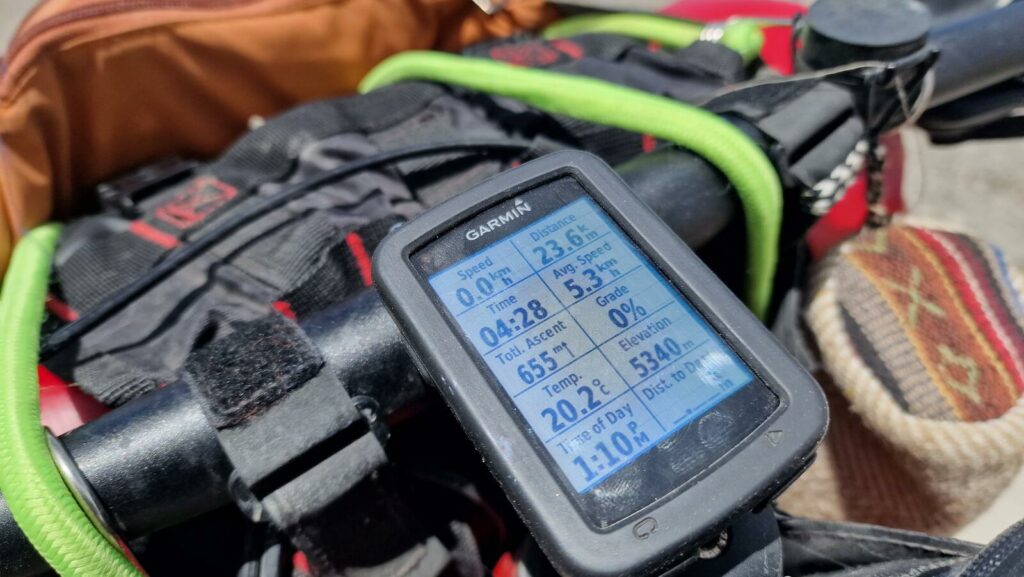
How to choose the best mountain bike computer?
A thorough comparison of the top speedometers and MTB GPS devices for sat nav
Whether you approach mountain biking as a hobby or a sport, chances are you still want to keep tabs on your performance. But what is the best mountain bike computer? Why should you use a GPS device?
Disclosure: Some of our articles contain affiliate links. This comes at no additional cost for you and helps us keep this website up and running. (as Amazon Associates we earn commission from qualifying purchases)
How we compile our gear guides: during the almost 10 years of cycloscope.net our team personally tested dozens of similar pieces of gear. For what we can't test personally, we involve other people in the cycling community to give their feedback and opinion about gear they have used. Our decade-long experience in bicycle touring enables us to find the key cons and pros of every product we mention.

While roadies and bikepacking enthusiasts might as well opt for one of the many smartphone apps, for mountain bikers having a dedicated bike computer is almost mandatory, unless you want to replace your phone every month.
An integrated computer is a highly efficient device. Sturdy, lightweight, and equipped with powerful batteries, these incredibly handy small gadgets can provide you with accurate data on anything about your bike ride, from speed to location and altitude, and of course a lot more.
This blog article aims to guide you through the choice of the perfect MTB computer for your needs.
Let’s dive into the products first, the list of the best mountain bike GPS models to date. while at the end of this guide, you’ll find out “how” to choose the right one for you.
Let us learn today how to choose the best MTB computer!
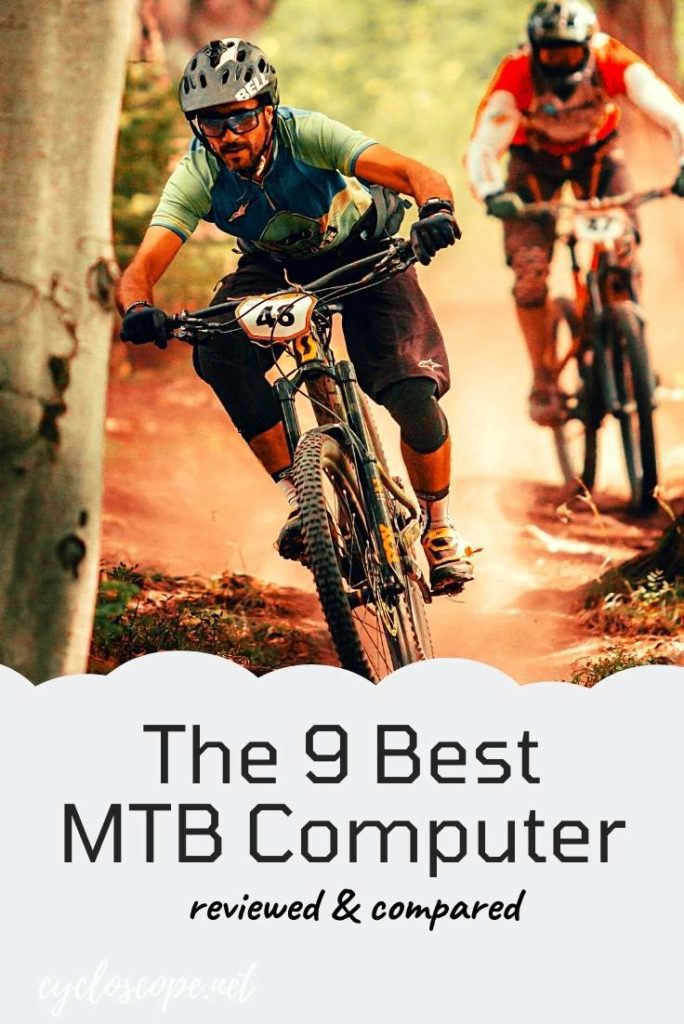
The 13 best MTB computers
in-a-nutshell
7 best GPS mountain bike computers
- Bryton Rider 420E [+/- $160]
- best budget MTB GPS
- Garmin Edge 1040 Solar [+/- $680]
- best MTB computer for Pro riders
- Garmin Edge 540/540 Solar [+/- $350-450]
- budget Garmin MTB GPS device
- Garmin Edge 840 Solar [+/- $550]
- best midrange Garmin MTB computer
- Wahoo ELEMNT ROAM V2 [+/- $400]
- an affordable MTB computer for pros
- Garmin Edge® Explore 2 [+/- $300]
- best GPS device for MTB touring
- Magellan Mio Cyclo 505 [+/- $350]
- good GPS unit for the USA only
3 best MTB Speedometers
- Bryton Rider 15 neo [+/- $65]
- best GPS tracker MTB computer
- Cateye Padrone [+/- $55]
- best mountain bike speedometer for minimalists
- Garmin Edge® 130 Plus [+/- $180]
- best entry-level Garmin computer
2 more honorable mentions
- Lezyne Mega XL [+/- $200]
- Hammerhead Karoo 2 [+/- $400]

The best MTB cyclo-computers
compared by price and technical specs
So, here we go! Let’s dive into the comparison of the best mountain bike computers! We have divided our selection into 3 categories to facilitate navigation.
7 best GPS mountain bike computers
Bryton Rider 420E [+/- $100]
best budget MTB GPS
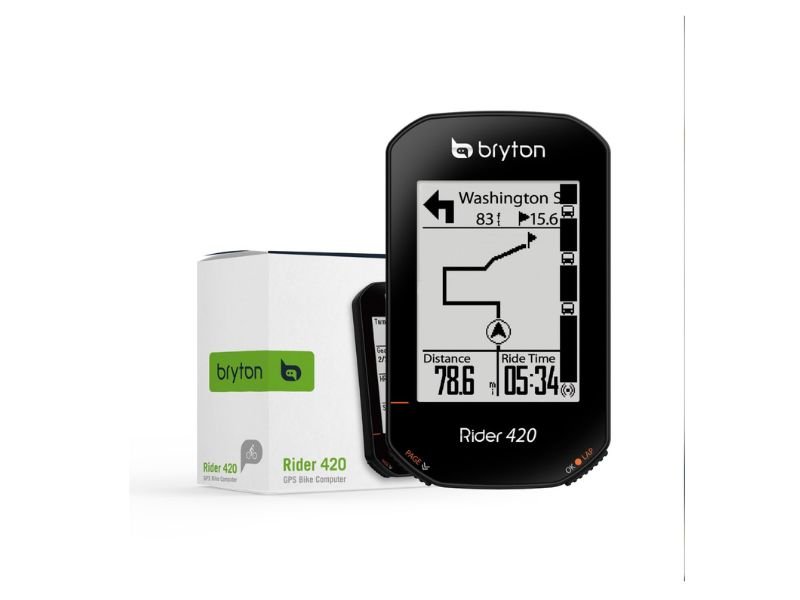
Let’s begin with a fairly inexpensive option, the Bryton GPS Rider 450, with a black and white but rather large and bright screen.
The interface allows indeed up to 10 data fields per page to allow a better understanding of performance in real-time.
Although BnW, the 420E is still a cartographic GPS, coming with preloaded OSM maps (Open Street Map).
Rider 420E now supports the electronic gearbox system, including Shimano Di2, Campagnolo’s EPS, and SRAM eTap. Instead of checking your crank and cassette, you can get all the gear information directly on the device, such as the gear ratio, gear combination, and even the battery life of the ESS.
It is able to receive European, Russian, Chinese, and Japanese satellites. It is equipped with an altimeter and good rechargeable batteries will keep it up to an astounding 35 hours.
- PROS: stunning battery life, cheaper than others, good phone app, barometric altimeter.
- CONS: basic routing, no touchscreen, B/W display.
Who is this for?
The Bryton Rider 420E is an absolutely no-bullshit MTB computer. Reliable and quick satellite reception and the longest battery life on the market of cartographic GPS for bikes, make this a great and cheap choice for those who like to get lost for days… weeks… or years.
Garmin Edge 1040 Solar [+/- $660]
best MTB computer for Pro riders

The smartphone-sized Garmin Edge 1040 Solar is probably the best MTB computer for real nerds. Being designed specifically for pro cyclists, it’s the most powerful cycling computer in this list, with tons of functions.
The amount of data provided by this device is astounding – maybe even overkill for an amateur – while the integration with smartphone apps opens a new world of possibilities.
The Popularity Routing function gathers all Garmin Connect data to give you a live heat map of the most popular routes, while the Strava Segment app lets you compare your performance in real-time with other users.
The new Power Glass solar charging lens enhances battery longevity, providing you with the potential for up to 100 hours in battery-saving mode or up to 45 hours in intensive usage scenarios.
When used during daytime rides, it contributes an additional 42 minutes per hour in battery-saving mode and up to 20 minutes per hour in demanding usage scenarios (assuming a consistent 75,000 lux illumination during daytime riding).
Features:
- USB rechargeable lithium-ion battery – up to 17h
- Altimeter, Compass, Strava segment, WiFi, Bluetooth, SD card slot
- (3.6″) 240 x 400 px multitouch screen
- PROS: everything you might ever want from a cycling computer and riding GPS device
- CONS: very expensive
Who is this for?
For those mountain bikers who want the best gear. For data nerds and pro riders.
Garmin Edge 540 [+/- $350-450]
budget Garmin MTB GPS device

The 530 and 540 are the little brothers of the Edge family. While the 530 is still in production and comes at a very affordable price, the Edge 540 and its solar version are the new babies, improving the device in some areas that were critical before.
The 540 has 6 more hours of battery life compared to the 530 (26h), while the solar version is able to add 6 more hours of continuous functioning (up to 32h in ideal conditions).
In these relatively cheap devices (350 USD), the screen is not touch-operated but has some buttons on both sides.
Both devices are compatible with Varia bike radar and lights and Strava Segments and feature advanced performance and power analysis, including new Time in Zone, FTP tracking, cycling-specific VO2 and recovery, and cycling dynamics.
Only the 540 though, is preloaded with Garmin Cycle Maps, and most importantly, allows for external memory. Since the real issue with the 530 series was the lack of an SD card slot and the ridiculous internal memory (51MB?! Was it the 90s?) it made it impossible to upload larger maps, now with the 540 this problem is solved. Have a look at the full comparison between the 530/540/540 solar.
They can operate at temperatures between -20°C to +55°C and are able to be paired with a smartphone via Bluetooth. Two more sensors have been added from the 530 version: Gyroscope
and Multi-band GNSS.
- PROS: altimeter, improved connectivity, round-trip navigation
- CONS: no touch screen (not sure that’s a pro or a con)
Who is this for?
The Edge 540 is a good-value cycling computer for mountain bikers who don’t venture too far. The USB-charged battery allows charging the device with a basic solar panel or battery pack.
Garmin Edge 840 Solar [+/- $550]
best midrange Garmin MTB computer
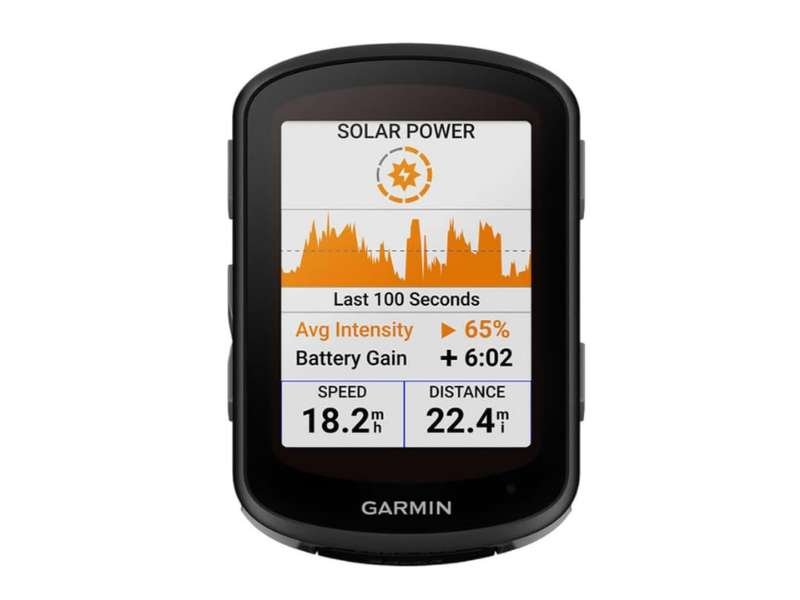
If the Edge 540 is the little brother, then the 840 is the one in between. The two units are the exact same size but the 840 Solar has a few more features, the most important being a touchscreen (instead of buttons), and 32 GB of built-in memory.
The Garmin Edge 840 presents all those training and workout features most race-bike-riders are fond of event-specific daily workout suggestions, primary and secondary workout targets, real-time stamina, cycling ability analysis, course demands analysis, unified training status, and more.
.An interesting feature, available also on the 540, is accident detection… a combination of sensors that should understand if you just had a crash, thus automatically notifying a contact of your choice via SMS.
- PROS: altimeter, improved connectivity, round-trip navigation
- CONS: solar is not very efficient
Who is this for?
The Edge 840 is the upgraded version of the 540. Thanks to the large enough built-in memory, these units can finally be considered by the most adventurous mountain bike travelers. Worth the 80/100$ more (compared to the 540).
Wahoo ELEMNT ROAM V2 [+/- $400]
an affordable MTB computer for pros
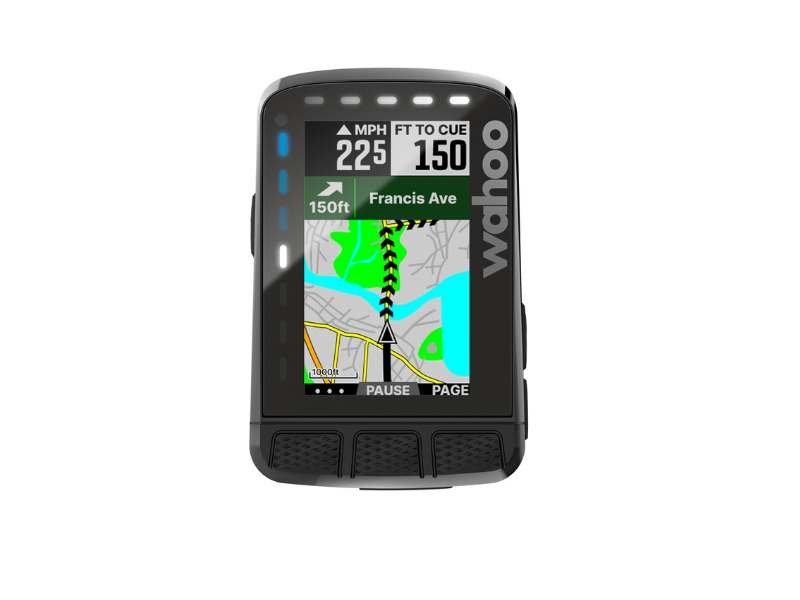
The Wahoo ELEMNT ROAM v2 presents notable updates within a familiar exterior. While its visual design remains largely unchanged, featuring the same screen size, LED indicators, and (slightly larger) button layout, the device boasts substantial enhancements in its functionality.
The Roam V2’s key advancements lie internally. It now incorporates dual-band GPS for enhanced accuracy, especially in challenging environments like areas with dense trees or tall buildings.
Storage capacity has been expanded to 32GB, accommodating a larger number of routes, maps, and workouts. The inclusion of a compass and gyroscope sensors offers potential benefits, though Wahoo has yet to fully implement their capabilities. The device introduces Summit Segments, aiding in pacing climbs, along with pre-loaded routes, Systm Outdoor Workouts for training, and Public Route Sharing.
Wahoo excels in user-friendliness. The screen remains easily readable on the go, and the map design ensures straightforward navigation. The accompanying app functions seamlessly, ensuring consistent synchronization between the device and the app.
While the claimed 17-hour battery life falls short compared to some competitors, the Roam v2 retains Wahoo’s convenient phone integration for simple setup and customization, global map downloads, and the quick-zoom function for adjusting displayed data fields.
Data capabilities are comprehensive. The device offers over 20 data field categories for customizable pages, encompassing metrics ranging from basics like distance and climbing to more advanced parameters such as muscle oxygen and power data options.
The Elemnt Bolt v2, controlled by buttons rather than a touchscreen, continues Wahoo’s legacy of easy setup and customization. The companion app streamlines screen personalization, reflecting changes instantly on the computer.
A standout feature is the SUMMIT functionality, which intuitively anticipates grade changes and utilizes color coding to enhance road visualization. The SUMMIT FREERIDE feature detects climbs in advance, and SUMMIT SEGMENTS provide visual cues for climbs regardless of the active screen.
The Elemnt Roam V2 complements the Wahoo Elemnt Bolt V2 in the product lineup. While the Bolt targets performance-oriented riders with a compact design and color screen for navigation, the Roam stands out as a larger unit, emphasizing navigation assistance. With a 2.7-inch display (compared to the Bolt’s 2.2 inches), the Roam offers extended battery life (up to 17 hours), dual-band GPS, and integrated accelerometer, gyroscope, and compass features.
PROS: cheaper than others, good phone app, barometric altimeter, magnetic compass, comes with 3 different mounts
CONS: short battery life
Who is this for?
The Wahoo ELEMNT ROAM v2 suits mountain bikers seeking an advanced GPS device without breaking the bank. It offers accurate navigation, customizable data fields, and Summit features to anticipate terrain changes.
Garmin Edge® Explore 2 [+/- $300]
best GPS device for MTB touring

Ok, this is getting insane, so many different Garmin models with very similar features, it is honestly challenging to understand the differences.
With the Explore 2 – compared to its more expensive sibling, the Edge 1040 – there’s less emphasis on training, no Strava Live Segments, no Virtual Partner, no Advanced Workouts.
The Explore is indeed Garmin’s series historically catering to bike touring, targeting users who prioritize a larger display and comprehensive navigation tools over advanced training metrics.
New features include an updated user interface, downloadable global cycle maps, a barometric altimeter, Garmin ClimbPro, and expanded sensor support (including power meters and inReach satellite). The eBike features have also been expanded.
Notable differences from the higher-end Edge 1040 include a lower price of $299, a smaller display, a lack of Strava Live Segment support, limited activity profiles, and no structured workout support.
Both models maintain color touchscreens, with the Explore 2’s 3-inch screen having a resolution of 240x400px. Despite lacking some high-end features, the Edge Explore 2 offers a balance of navigation capabilities and essential data for cyclists who seek dependable guidance and larger-screen real estate, making it a versatile choice for a wider range of riders.
It does feature an accelerometer for Incident Detection and supports e-bike monitoring.
An important improvement on the first Explorer is the longer battery life. Garmin indeed added a battery saver option for 24 hours of battery life in navigation mode (up to 34 hours GPS ride time w/o nav).
PROS: altimeter, WiFi, great routing
CONS: no SD card slot
Who is this for?
The Edge Explore 2 is the best GPS computer for MTB touring. For those rider who want a reliable navigator and do not care too much about training data.
Magellan Mio Cyclo 505 [+/- $350]
good GPS unit for the USA only

For about half the price of a Garmin Edge 820, the Mio/Magellan Cyclo 505 has almost all the same functionality plus some more. It can display a lot of data, including barometric altitude and road gradient, right-left power balance, and pedaling efficiency.
It can be synced to a smartphone for calls and messages notifications, can auto-upload data via Bluetooth or WiFi to Strava, and can control your phone music from the dashboard. Battery life is between 8 and 12 hours even when paired to various devices, the heart rate strap comes included with the unit.
The Mio Cyclo 505 is more oriented towards the touring side in comparison to the training aspects.
Its routing and mapping are pretty evolved, providing turn-by-turn directions to streets, postcodes, or points of interest. You can also download and follow pre-planned routes in GPX form, manually choose to avoid a specific road and ride Strava Live Segments.
It comes preloaded with a detailed map of Western Europe OR Australia OR North America… and here comes the main flaw: NO MAPS CAN BE ADDED TO THE PREEXISTING ONES, no OSM (OpenStreetMap) support, neither the chance to buy the maps for the rest of the world.
- PROS: affordable, very clear and readable screen and base map, advanced routing, and connectivity
- CONS: no possibility of adding maps
Who is this for?
The Magellan Mio Cyclo 505 is a perfect cycling GPS navigator for those planning to cycle only on their own continent.
3 Best MTB Speedometers
Bryton Rider 15 neo [+/- $54]
best GPS tracker MTB computer

If what you’re looking for is mostly a speedometer and MTB computer and does not need navigation, the Bryton Rider 15E Neo offers a straightforward, budget-friendly GPS cycling computer option.
With a compact design and simple interface, it’s ideal for cyclists seeking essential ride data without complex features.
Setup is quick, and battery life impressively reaches around 13.5 hours with practical usage. Its monochrome 2-inch screen may seem busy initially, but once data locations are familiar, it proves easy to read and navigate while riding.
This computer provides standard metrics—speed, time, distance—augmented by GPS and Bluetooth capabilities.
Altitude, gradient, temperature, heart rate, and cadence can also be displayed through sensor pairing, although the lack of ANT+ compatibility limits sensor options.
Notably, the unit lacks mapping, even breadcrumb trails or turn-by-turn arrows, which limits route navigation but is less concerning for riders who primarily stick to familiar paths.
The Rider 15E Neo, priced at $64.99 (15E version), includes the unit, USB charging cable, handlebar mount with various rubber bands, and a quick start guide.
While its lack of advanced features might deter data enthusiasts, for those who prioritize simplicity and affordability, this GPS computer proves a reliable option, providing core ride metrics and GPS tracking without unnecessary frills.
Cateye Padrone [+/- $55]
best mountain bike speedometer for minimalists
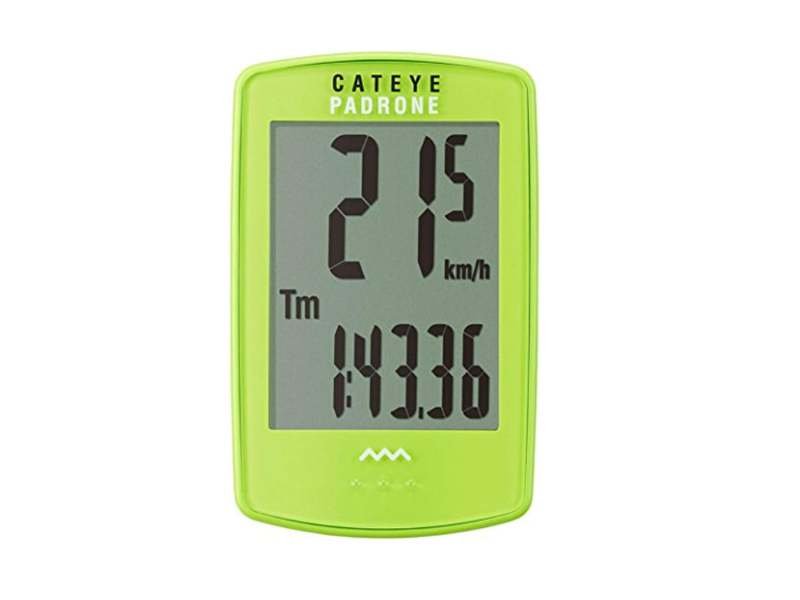
The Cateye Padrone is a reliable cycling computer and speedometer that excels in simplicity and functionality. While lacking GPS capabilities, it fulfills basic cycling data needs exceptionally well.
The larger screen, 85% bigger than Cateye’s Urban Wireless, provides easy-to-read metrics like current speed, total distance, trip distance, elapsed time, max and average speed.
Its slim profile, 22% thinner than comparable models, enhances aesthetics and mounting options. Setup is hassle-free with a speed sensor, magnet, and two-part mount, allowing bar or stem placement. Scrolling between screens is intuitive, and the unit weighs a mere 31.5 grams.
Though it lacks GPS, the Padrone remains an attractive option for those who prioritize essential ride data over navigation.
Its simplicity, easy setup, lightweight design, and comprehensive metrics make it a reliable companion for various cycling activities. The only notable challenge lies in removing the unit from the bracket due to a secure fit.
Who is this for?
For cyclists seeking a straightforward cycling computer without GPS complexities, the Cateye Padrone stands as an effective and user-friendly choice.
Garmin Edge® 130 Plus [+/- $180]
best entry-level Garmin computer
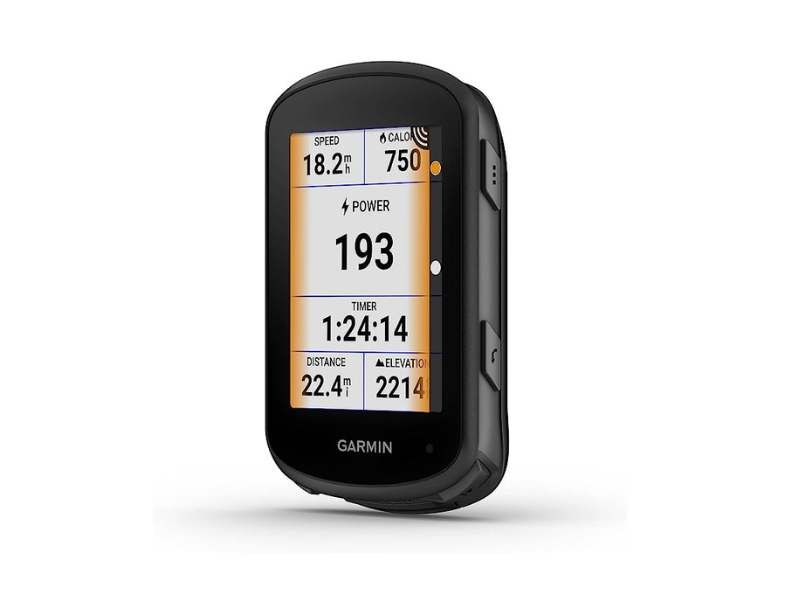
The Garmin Edge 130 Plus stands out as the brand’s smallest and one of the most compact cycling computers available. Despite its diminutive size, it packs a punch in terms of features.
The device’s straightforward design comprises five buttons for easy navigation. Its simplicity is refreshing, offering a singular ‘ride’ profile with no multiple bike options.
For mountain biking, the Edge 130 Plus introduces valuable updates. The inclusion of hang time dynamics, which record jump distances and heights, enhances the experience for off-road enthusiasts.
Furthermore, the ‘ClimbPro’ feature provides detailed climb information during planned routes, making it especially useful for navigating challenging terrains. Garmin’s PhysioTrueUp ensures accurate physiological data across multiple devices, enhancing training insights.
The device supports various training sensors via Ant+ and Bluetooth, including power meters, heart rate monitors, and more. With compatibility across GPS satellites, including GPS, Galileo, and GLONASS, it ensures reliable tracking.
Additionally, its stable smartphone connection and notification features, such as WhatsApp messages, are convenient for connected riding.
While lacking advanced mapping capabilities compared to larger models, the Edge 130 Plus offers excellent value for its compact size.
It’s versatile enough to excel on daily commutes or longer rides, including lighter navigational tasks.
Who is this for?
Overall, its combination of size, features, and reliability makes the Garmin Edge 130 Plus an appealing choice for mountain bikers seeking a capable and compact cycling computer.
2 more honorable mentions for the best MTB computer
Three more products have enticed our curiosity but we didn’t have the chance to test them, we hope to write more about them in the future.
How to Choose the Best Computer for Your Mountain Bike

Many people still believe that adding a computer to your MTB setup is a hassle. reality couldn’t be more different. Mountain bike computers are neither large nor intrusive. They might have been at first, but a lot about them has improved since then.
Now, riders from all over the world can benefit from real-time data provided by a compact and elegant computer, able to track time, speed, distance, elevation, and more.
The best part about attaching one to your mountain bike is that such a gadget might be enough to improve anyone’s skill set. Here are the most significant things you need to know about choosing the right MTB computer for you.
Bike Computer VS Smartphone
Although smartphone apps have pretty evolved functionalities and bike phone holders have become safer, this combo is still far from matching the convenience of a cycling computer.
Mountain bike computers are built to take all the hardships of the road without flinching. They last forever, and so do their batteries when compared to a phone tracking a route.
It is not always easy to find a place to recharge, especially if you are bikepacking in the wild. Of course, there are battery packs or portable solar panels that can guarantee you a few days of battery life, but… nothing compared to the life of the best GPS MTB computer, which can reach up to 72 hours in constant use.
Another reason is that all cycling computers are fully waterproof. Let’s say the same can’t be said about smartphones, except for some heavy-duty models.
With a dedicated device, all the info will always be on hand: you can track your position, your average speed, your ETA, and even your cadence.
Some of the most advanced cycling computers can also give you information about your gears their ratio, and your heartbeat, they can even be uploaded in real-time on Strava!
So, to summarize, the strengths of MTB computers are:
- resistance to falls, impacts, and accidents in general
- battery life
- water resistance
- advanced performance meters
Pro tip: use apps on your smartphone or PC to create routes and itineraries, then import it to your GPS device to follow it.
What Type of Rider Are You?
The first step in choosing the perfect mountain bike computer to suit your needs is to determine the type of rider you are. Depending on your skill level, performance, and the amount of time you allot for the activity, you are either a beginner, a casual biker, an enthusiast, or a competitive athlete.
How to Choose MTB Computers for Beginners
As a rule, beginner mountain bikers do not need to visualize too much data. Therefore, a primary computer that displays total distance, average speed, and duration is more than enough. It is also mostly right for casual riders.
- Pick a basic unit that is small, lightweight, with a long battery life;
- For essential purposes, you can find affordable models that will meet your needs entirely.
How to Choose MTB Computers for Advanced/Enthusiasts
When it comes to enthusiastic riders who see MTB as a hobby, things tend to change a little.
Belonging in this category means that you most likely made a habit out of hitting the trails during the weekend.
You might even be training to expand your skillset and become stronger in regard to the sport.
For this reason, you will benefit from supplementary data such as a speed and cadence sensor and a heart rate indicator.
- Pick a device featuring such additions to the basic package; they will turn your mountain bike computer into a reliable ally on your journey toward peak performance.
- Keep in mind that the device’s interface has to be user-friendly, meaning that you can access any information you want with great ease.
- Such MTB computers may be larger and heavier than their simpler brethren may, and probably more expensive. However, if you want reliable metrics to smoothen your path from “enthusiast” to “professional,” such investments will pay off. You have to know a few more things before we tackle the “expert” category of riders.
- If you have an interest in collecting collateral data related to your rides, such as heart rate, pedaling cadence, and power, you need connectivity and peripherals for your device. Of course, you can buy cadence sensors and heart rate straps as extra gadgets or together with a GPS bundle unit.
- Remember, however, that you will probably have to pay more for power meters.
How to Choose MTB Computers for Pros
Finally, it is time to discuss the needs of the professional athlete. If you perform MTB professionally, then you already know that a basic gadget or one with minor extra features won’t be enough.
- Smartphone connectivity, tracking, WiFi, navigation, temperature, and altimeters are thus required at this point;
- You should not forget the ANT+ interface – a feature you will find useful and often encounter in the majority of new GPS units.
Fulfilling Your Tech Needs
Another aspect to keep in mind when choosing your mountain bike computers has to do with the fulfillment of tech needs.
Many casual riders feel like the investment is a superfluous one, as everyone has a smartphone nowadays that can easily substitute for such a gadget via a specialized app.
While it is true that these apps can perform essential functions such as tracking distance or speed, they are counterproductive in the long run.
Not only do most additional features require paying an extra fee, but they quickly take a toll on your phone’s battery life.
After a while, you might find your device depleted mid-ride, with all your previous progress lost.
While the sensors inform you of aspects such as speed, heart rate, or cadence, the GPS calculates distance, aids your navigation, and lets you know what the altitude is as well. With all this information, you are bound to perfect your riding style and become more than a casual or enthusiastic mountain biker, but only if that’s what you want, of course.
Moreover, they need individual cases to mount the phones on the handlebars in the correct position, and these cases are not cheap.
Using a smartphone instead of an MTB computer comes with many other drawbacks (accidents destroying your expensive phone being just the tip of the iceberg). For this reason, your best bet is purchasing a wireless computer. They are relatively inexpensive, and they manage to do the job accurately thanks to integrated sensors. Moreover, they come with a solid build and resistance to wear, tear, and everything cool mountain biking involves.
- For added functionality, choose one with an inbuilt GPS system, and do not forget about the ANT+ interface you will not find in most smartphones.
The advanced versions of computers also include data collection and provision regarding calories burned, smart alerts including weather, turn-by-turn navigation, on-screen text messages, emails, and phone-call notifications, Bluetooth connectivity (besides the ANT+), incident alerts, battery save mode, and stress score, among others.
The Bottom Line
Mountain bike computers are hardly the bulky devices they once were. With the progress of technology, riders now benefit from sleek and optimized gadgets that can track anything from speed to heart rate and tell you exactly where you are at all times.
Depending on the type of biker you are, and the tech needs you have, you will undoubtedly find something out there that works for you and with you in perfect balance.
Check our article
> The Best GPS for Bike Touring and Bikepacking

